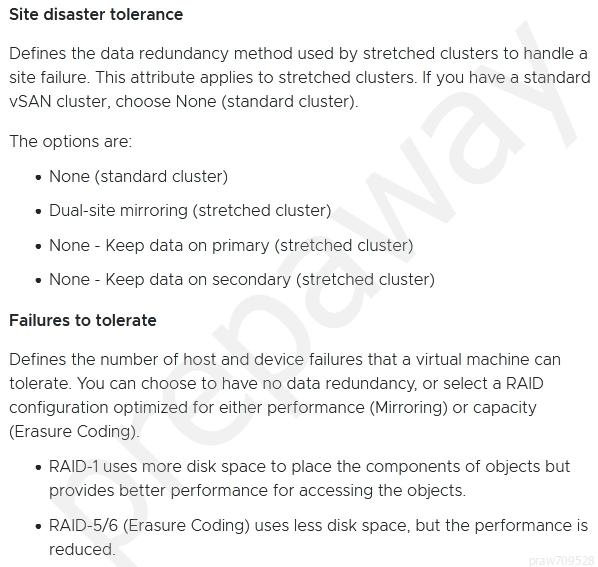VMware Cloud on AWS Master Specialist v1.0
Question 1
A user with an Organization Member role would like to add another user to an organization. How would this be accomplished?
- A. Only users with an Organization Owner role can invite and add users to the organization.
- B. The user with an Organization Member role needs to have CloudAdmin permissions in order to add a new user.
- C. The user with an Organization Member role will be able to add a new user through the Identity and Access Management page.
- D. Users with an Organization Member role are automatically granted access to all roles within VMware Cloud on AWS.
Answer : A
Explanation: A -
Reference:
https://docs.vmware.com/en/VMware-Cloud-on-AWS/services/com.vmware.vmc-aws.getting-started/GUID-9CAB2B3E-42D5-44A1-9428-
E8FFD22BDD01.html -
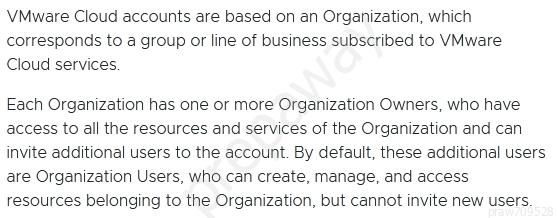
Question 2
When deploying a VMware Cloud on AWS software-defined data center (SDDC), which three default components are located behind the T1 Management
Gateway? (Choose three.)
- A. Three-node VMware NSX-T Controller Cluster
- B. VMware vCenter Server
- C. VMware Site Recovery
- D. VMware vRealize Log Insight
- E. VMware NSX-T Data Center Manager
- F. VMware HCX Cloud Manager
Answer : BCD
Question 3
A customer is deploying a new solution based on VMware Cloud on AWS. The customer is already running several native AWS services and would like the new workloads deployed into VMware Cloud on AWS to consume these services without incurring additional traffic charges. During the initial deployment of the
VMware Cloud on AWS software-defined data center (SDDC), which option must the customer choose to meet the requirement?
- A. Choose a connected Virtual Private Cloud (VPC) that is located in the same region as the native AWSservices to be consumed.
- B. Any availability zone within the same AWS region can be selected. After the SDDC deployment, deploy a services gateway and connect it to the target availability zone.
- C. Choose a subnet from the connected Virtual Private Cloud (VPC) that is located in the same availability zone as the native AWS services to be consumed.
- D. Choose a connected Virtual Private Cloud (VPC) that is located in the same availability zone as the native AWS services to be consumed.
Answer : A
Question 4
Which statement is true regarding how vSphere High Availability (HA) provides rapid recovery from outages in VMware Cloud on AWS?
- A. Sphere HA restarts virtual machines if their host becomes isolated on the VMware vSAN network.
- B. vSphere HA restarts impacted virtual machines on another host when an application fails.
- C. vSphere HA is enabled by default in VMware Cloud on AWS but can be disabled or modified.
- D. vSphere HA restarts impacted virtual machines (VMs) on another host when a VM stops sending heartbeats or the VM process fails (vmx).
Answer : B
Explanation:
Hosts in the cluster are monitored and in the event of a failure, the virtual machines on a failed host are restarted on alternate hosts.
Reference:
https://docs.vmware.com/en/VMware-vSphere/7.0/com.vmware.vsphere.avail.doc/GUID-33A65FF7-DA22-4DC5-8B18-5A7F97CCA536.html
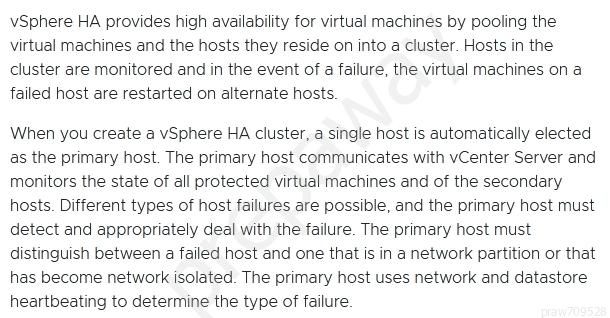
Question 5
A company is operating a main data center and two smaller data centers in branch offices. The main data center is being replicated to a disaster recovery site at a co-located data center with a recovery point objective (RPO) of five minutes and a recovery time objective (RTO) of two hours. The branch data centers are shipping backup tapes to the main data center on a weekly basis. What would be a cost-efficient VMware solution that would improve RTO and RPO for the branch office data centers while maintaining the recovery time for the main data center?
- A. Create a software-defined data center (SDDC) in VMware Cloud on AWS. Create a shared content librand let the branch offices subscribe to it. Export the virtual machines in the branch offices to OVF files on the shared content library on a weekly basis.
- B. Create a software-defined data center (SDDC) in VMware Cloud on AWS. Migrate the disaster recovery solution from the co-located data center to the VMware Cloud on AWS SDDC. Create regular copies of the virtual machines at the branch offices and use AWS Snowball to directly ship the copies to an AWS data center and store them on AWS S3 buckets.
- C. Create a software-defined data center (SDDC) in VMware Cloud on AWS. Activate VMware Site Recovery. Replace the co-located disaster recovery (DR) site for the main data center with VMware Site Recovery. For the branch offices, implement VMware Cloud Disaster Recovery (VCDR).
- D. Create a software-defined data center (SDDC) in VMware Cloud on AWS. Replace the co-located site for the main data center and the backup tape shipping for the branch offices with VMware Cloud Disaster Recovery (VCDR).
Answer : A
Question 6
A customer plans to use VMware Cloud on AWS to support their public cloud adoption initiatives. Their use case for VMware Cloud on AWS is predominately data center extension to support seasonal and business specific demands. There will also be a number of workloads running in VMware Cloud on AWS on a long-term, permanent basis. Based on a recent sizing assessment, it is determined that utilization of VMware Cloud on AWS will fluctuate between two and five hosts throughout the year based on seasonal and market conditions. Which possible subscription option would result in the greatest benefit to this customer and why?
- A. Create a subscription for five hosts for three years. This option provides the greatest cost savings to the customer and eliminates the amount of time needed to provision and configure VMware ESXi hosts as consumption fluctuates.
- B. Create a subscription for two hosts for one year and consume the remaining hosts, as needed, on-demand. This option allows the customer to lock in a term rate for required hosts and leverage on-demand rates for additional hosts as needed.
- C. Consume VMware Cloud on AWS on-demand based on seasonal and business requirements. This option provides the cost benefits of cloud through an on- demand consumption model.
- D. Create a subscription for three hosts for three years and consume the remaining hosts, as needed, on-demand. This option allows the customer to lock in a term rate for required hosts and leverage on-demand rates for additional hosts as needed.
Answer : D
Question 7
An administrator is preparing to deploy a VMware Cloud on AWS software-defined data center (SDDC) and is planning to scale up to 48 nodes in the future. What is the minimum size management CIDR block that is needed to meet this requirement?
- A. /24
- B. /16
- C. /23
- D. /20
Answer : D
Explanation:
The management CIDR must be one of 3 available sizes: /16, /20 or /23. The primary factor in selecting the size is the anticipated scalability of the SDDC. In single-AZ deployment, a /23 CIDR can support 27 ESXi hosts, while a /20 can support up to 251.
Reference:
https://blogs.vmware.com/cloud/2019/10/03/selecting-ip-subnets-sddc/
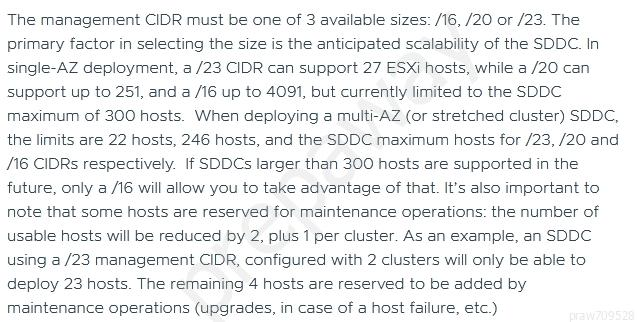
Question 8
Due to a recent acquisition, an architect is being asked to identify and design a cloud-based solution that will assist in merging several data centers together without incurring undue operational overhead while adhering to a very strict project timeline. The proposed solution must have the capability to be rapidly recovered in the event of a cloud provider outage. After careful consideration, the architect determines that VMware Cloud on AWS would be an appropriate solution, requiring a total of nine hosts for capacity. Which additional configuration options would satisfy the requirements of this project?
A.
✑ Deploy a VMware Cloud on AWS software-defined data center (SDDC) with a single stand-alone cluster.
✑ Deploy a second stand-alone cluster into the SDDC in a separate region.
✑ Configure VMware Cloud Disaster Recovery to replicate and protect workloads to the second cluster.
B.
✑ Deploy a VMware Cloud on AWS software-defined data center (SDDC) with a single stretched cluster across two separate availability zones.
✑ Configure the cluster to ensure that all virtual machines can be restarted in the second availability zone with a near zero recovery point objective (RPO) in the event of any environment or system failures.
C.
✑ Deploy a VMware Cloud on AWS software-defined data center (SDDC) with a single stretched cluster across two separate regions.
Configure the cluster to ensure that all virtual machines can be restarted in the second region with a near zero recovery point objective (RPO) in the event

D.
✑ Deploy a VMware Cloud on AWS software-defined data center (SDDC) with a single stand-alone cluster.
✑ Deploy a second SDDC with a stand-alone cluster into a different AWS region.
✑ Configure VMware Cloud Disaster Recovery to replicate and protect workloads to the second cluster.
Answer : B
Question 9
Which two statements are true for the pre-defined resource pools in VMware Cloud on AWS? (Choose two.)
- A. Users are allowed to monitor and modify the resource allocation settings in the Mgmt-RsourcePool.
- B. The Mgmt-ResourcePool is able to utilize resources in subsequently created clusters if needed.
- C. Users can modify the pre-configured vSphere DRS settings in their own Compute-ResourcePool.
- D. Users can rename child resource pools to better match company policy.
- E. All workload virtual machines are created in the top-level (root) Compute-ResourcePool by default.
Answer : DE
Explanation:
Rename the resource pools to better match company policy.
By default, all workload virtual machines are created in the top-level (root) Compute-ResourcePool.
Reference:
https://docs.vmware.com/en/VMware-Cloud-on-AWS/services/vmc-aws-manage-data-center-vms.pdf https://docs.vmware.com/en/VMware-Cloud-on-AWS/services/com.vmware.vsphere.vmc-aws-manage-data-center-vms.doc/GUID-CCC16E07-7017-44B4-948E-
A558A87BA070.html -

Question 10
What is a key functionality of the vRealize Automation Cloud Service Broker?
- A. Provides a common catalog for easy consumption on VMware Cloud.
- B. Manages blueprints as a code in a YAML format.
- C. Automates the DevOps release lifecycle.
- D. Creates and deploys virtual machines, applications, and services to multiple clouds.
Answer : A
Explanation:
Provide a catalog of templates and actions to your VMware Service Broker consumers.
Reference:
https://docs.vmware.com/en/VMware-vRealize-Automation-Cloud/index.html
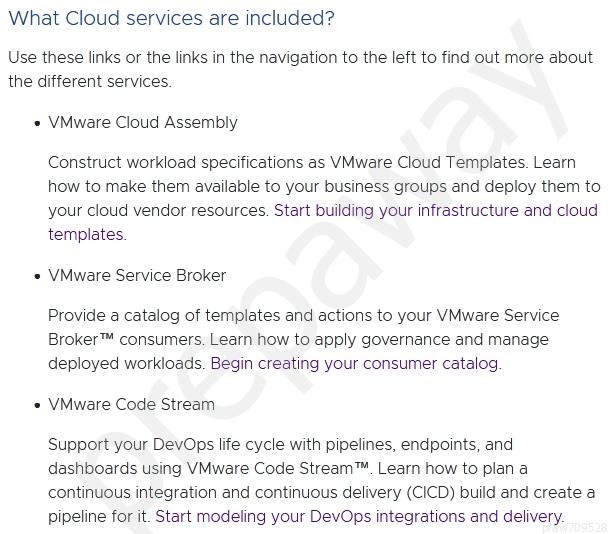
Question 11
When deploying within VMware Cloud on AWS, which three VMware Horizon features are supported? (Choose three.)
- A. Linked clone desktops
- B. Instant clone desktops
- C. Full clone Remote Desktop Session Hosts (RDSH)
- D. Persona management
- E. Unmanaged desktops
- F. Full clone desktops
Answer : BCF
Explanation:
Deploying desktops on VMware Cloud on AWS with Instant Clone.
VMware Cloud on AWS and need virtual desktops and Remote Desktop Session Hosts (RDSH) to be co-located with your published applications.
In addition to using Full Clones, you can also leverage Instant.
Reference:
https://www.vmware.com/content/dam/digitalmarketing/vmware/en/pdf/products/vmw-deploy-horizon-seven-on-vmware-cloud-on-aws.pdf
Question 12
A customer is running a software-defined data center (SDDC) in the US-West-1 region and wants to connect the workload network segment to their on-premises data center and their company Amazon Virtual Private Cloud (VPC) running in US-West-1. Which two supported connectivity options can they use to accomplish this? (Choose two.)
- A. One virtual private network (VPN) and one VPC Peering
- B. VMware SD-WAN by VeloCloud
- C. VMware Managed Transit Gateway (VTGW)
- D. Two virtual private networks (VPNs)
- E. VMware HCX
Answer : BD
Question 13
An administrator is looking to establish a hybrid connection between on-premises and VMware Cloud on AWS software-defined data center (SDDC) environments in order to migrate virtual machines. The on-premises environment is NOT using NSX today; however, the administrator wants to avoid having to change IP addresses after each migration, and there are some applications that require the same broadcast domain. Which connection is needed to meet these requirements?
- A. Policy-based VPN
- B. Layer 2 VPN (L2VPN)
- C. AWS Direct Connect
- D. Route-based VPN
Answer : D
Question 14
What are three valid migration modes in VMware HCX? (Choose three.)
- A. Planned Failover
- B. Hybrid Linked Mode
- C. Bulk Migration
- D. Replication Assisted vMotion (RAV)
- E. HCX vMotion
- F. Cross vCenter vMotion
Answer : CDE
Reference:
https://www.vmware.com/content/dam/digitalmarketing/vmware/en/pdf/products/hcx/vmw-hcx-deployment-considerations-and-best-practices.pdf
Question 15
An administrator deploys a normal (non-stretched) cluster of six i3en.metal hosts in VMware Cloud on AWS. When deploying virtual machines to this cluster, which two of the listed storage policies would satisfy the service-level agreement (SLA) for a six host cluster? (Choose two.)
- A. Failure to tolerate = 1 failure - RAID-1 (mirroring)
- B. Site disaster tolerance = Dual Site Mirroring
- C. Failure to tolerate = 1 failure - RAID-5 (erasure coding)
- D. Failure to tolerate = 2 failures - RAID-6 (erasure coding)
- E. MC Workload Storage Policy - <cluster name>
Answer : BD
Explanation:
Stretched clusters with six or more hosts use 1 failure - RAID-1 (Mirroring), but also have Site Disaster Tolerance set to Dual Site Mirroring.
Clusters containing 6 or more hosts use 2 failures - RAID-6 (Erasure Coding).
Reference:
https://docs.vmware.com/en/VMware-Cloud-on-AWS/services/com.vmware.vsphere.vmc-aws-manage-data-center-vms.doc/GUID-EDBB551B-51B0-
421B-9C44-6ECB66ED660B.html
